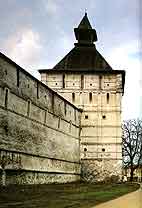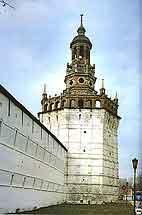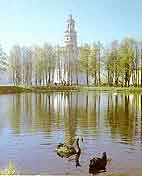 The Bell Tower is opposite the Tsar Palace housing the Theological Seminary since 1742. Near the Tower there was a bell ringing at the beginning and at the end of the lessons. It determined the Tower’s name. The Tower is rectangular in plan. It is decorated with pilasters and small arches. Originally it was called the Blacksmith’s Tower, as it was near the blacksmiths shop and one could hear a constant metal clink there.
The Bell Tower is opposite the Tsar Palace housing the Theological Seminary since 1742. Near the Tower there was a bell ringing at the beginning and at the end of the lessons. It determined the Tower’s name. The Tower is rectangular in plan. It is decorated with pilasters and small arches. Originally it was called the Blacksmith’s Tower, as it was near the blacksmiths shop and one could hear a constant metal clink there.
The Duck Tower (17 c.)
 In the north-eastern corner there was a granary yard that gave the original name for the Tower. Subsequently the Granary Tower was called the Duck Tower. Richly decorated with flat pilasters, friezes, figured loop-holes, the Tower is crowned with an uprising red and white superstructure added in the late 17th century, when decorativeness and multi-colored patterns were leading themes in Russian architecture. The superstructure made the Tower so extraordinary. It combines strength and gala festivity. The perfect correlation of the lower and upper parts, elegant proportions and light silhouette align the Tower with the outstanding monuments of the 17th century architecture.
In the north-eastern corner there was a granary yard that gave the original name for the Tower. Subsequently the Granary Tower was called the Duck Tower. Richly decorated with flat pilasters, friezes, figured loop-holes, the Tower is crowned with an uprising red and white superstructure added in the late 17th century, when decorativeness and multi-colored patterns were leading themes in Russian architecture. The superstructure made the Tower so extraordinary. It combines strength and gala festivity. The perfect correlation of the lower and upper parts, elegant proportions and light silhouette align the Tower with the outstanding monuments of the 17th century architecture.
 ÂOn top there is a small drum and a stone duck on a fleche. According to the local legend, Peter I liked to shoot ducks in the White Pond from this Tower. Since 1863, it was used as a water-tower. The water supply was cut off only in 1962.
ÂOn top there is a small drum and a stone duck on a fleche. According to the local legend, Peter I liked to shoot ducks in the White Pond from this Tower. Since 1863, it was used as a water-tower. The water supply was cut off only in 1962.
|


